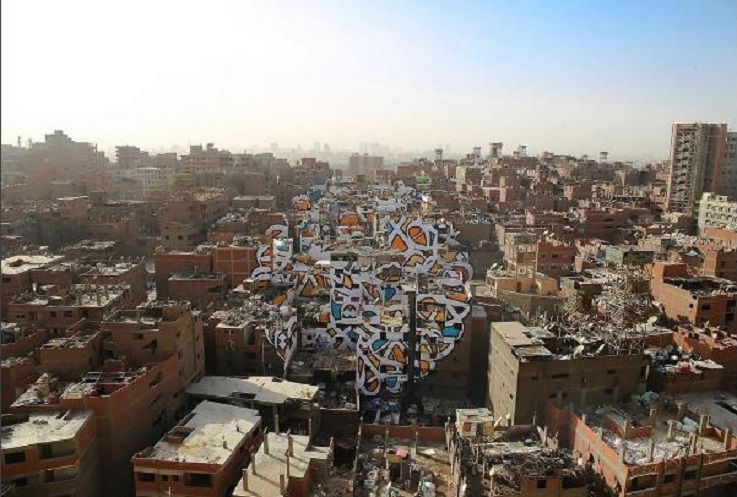A project of peace: Students learn the unifying power of art
Imagine yourself walking through the streets of a small district of Cairo, Egypt, perhaps on a study abroad trip with Woods Around the World. As you weave through the narrow streets, dodging trucks overflowing with trash, you are overcome by the pungent smell of rotting garbage.
You make your way past the piles of trash, beyond the city, and up to a famous lookout point atop the neighboring Mokattam Mountain. As you reach the top you peer out onto this “garbage city” from a new angle.
Across over 50 of these worn and dust-coated buildings is a vibrantly colored mural swirling in shades of orange and blue and white. A nearby local proudly looking down on his colorful home translates for you the Arabic words painted across the structures:
“Anyone who wants to see the sunlight clearly needs to wipe his eyes first.”
This is the most recent creation of French-Tunisian artist eL Seed, famous for producing street art that infuses graffiti with Arabic calligraphy to share powerful messages of hope.
 elSeed’s Project Perception in Cairo’s Manshiyat Naser neighborhood / Photo Credits: el Seed
elSeed’s Project Perception in Cairo’s Manshiyat Naser neighborhood / Photo Credits: el Seed
At first glance the city of Manshiyat Naser is seen as dirty — its residents often referred to by local communities as “the people of the garbage.” What you do not see is that they are a town of hope, filled with collaborative innovators. They make their living collecting the garbage of Cairo, through which they have developed one of the most efficient, highly profitable trash collecting systems.
“If you want to go to a place and know its people, you cannot judge them without knowing them”, explained Seed as he discussed in a recent TED Talk why he chose this message for this specific community. “You must get rid of the wrong ideas you have about them.”
Working in the community every day, Seed got to know the people whose houses he was painting on, and as the project progressed it became less about a piece of art work, and more about a tool to open peoples eyes and demolish preconceived notions.
“It was not about beautifying a place by bringing art to it,” explained Seed. “It was about switching perception and opening a dialogue on the connection that we have with communities that we don’t know.”
Forming connections, bridging the gaps of humanity, and promoting unity — Art has the power to do all that.
William Woods’ courses like Art History Beyond Western Art give bachelors of fine arts students the opportunity to see this truth unfold through history as they study the effects of art around the world. Students will learn the motivation behind the creation of different forms of art and how it has been used to reflect the history, politics, religion and geographic location of various cultures.

